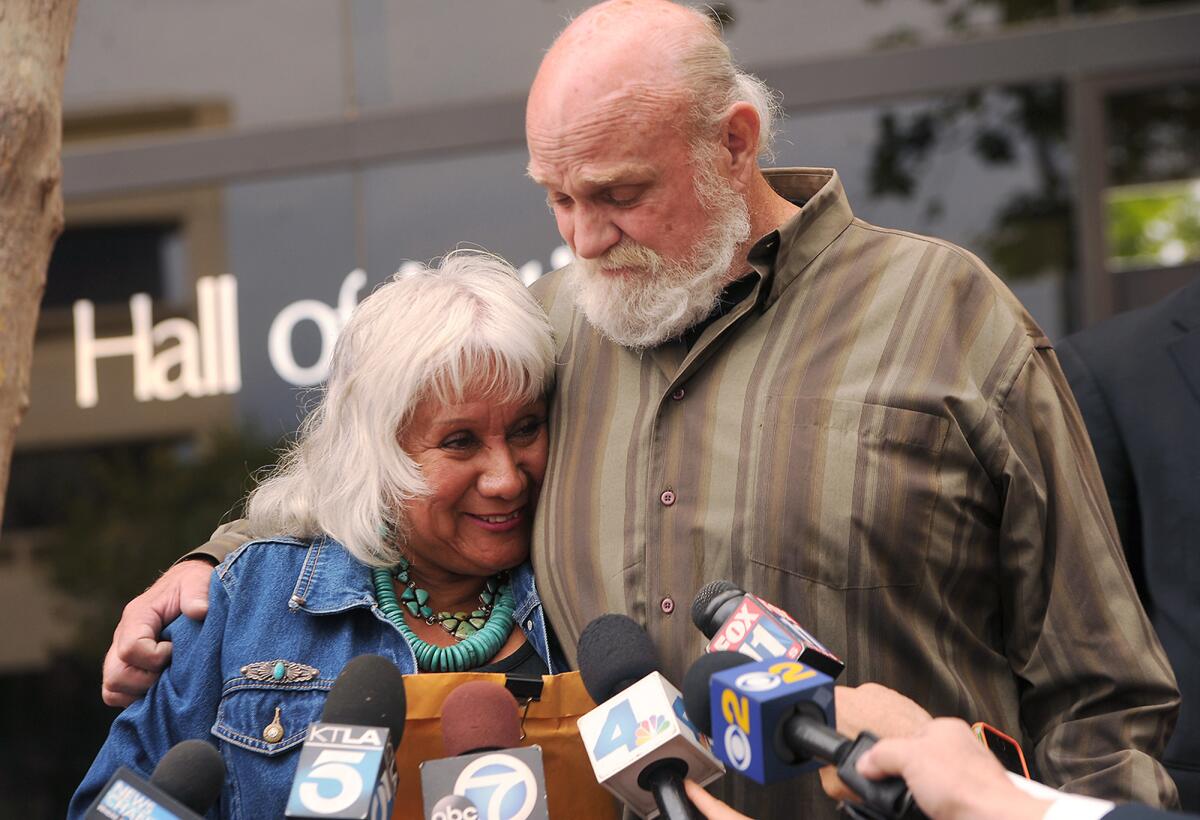Opinion: When the criminal justice system doesn’t find justice

Michael Hanline and his wife Sandy after his case was dismissed in Ventura in April. He had served 34 years of a life sentence for murder.
Imagine that the lies of others led a jury to convict you of a serious crime you didn’t commit, and it took nine years for the truth to set you free.
That’s the predominant circumstance of people whose wrongful convictions have been tracked by the National Registry of Exonerations, which since 2012 has built an impressive database. Interestingly, in a society where infatuation with forensic science has propelled the hit “CSI” television franchise, dogged investigation rather than DNA has revealed most of these miscarriages of justice.
The registry recently added a new graphic that’s pretty interesting - it tracks exonerations by the year in which the person was wrongfully convicted. According to its May newsletter (which eventually will be posted online here), wrongful sexual-assault convictions evened out around 1983 and then dropped off after 1991, even as wrongful convictions on other charges increased. (Note: These are the tracked exoneration cases, not all cases, which is unknowable). From the newsletter:
“Most rape exonerations are based on post-conviction DNA evidence that proves the innocence of defendants who did not have the benefit of pre-trial DNA testing. After 1990, pre-trial DNA testing became increasingly common in America; by 2000 it was the rule across the country. Judging from the data, pre-trial DNA testing has reduced the rates of false convictions and exonerations for rape: Rape cases are 20% of exonerations for convictions before 2000, but only 9% of exonerations for convictions since 2000; and rape exonerations that have occurred since 2000 are overwhelmingly for convictions from before 2000.”
Separately, the Innocence Project reports that of 329 post-conviction exonerations based on DNA evidence, 297 involved sex-crime allegations, and 111 were homicide (again, often an overlap).
So what does the Registry list as the contributing factors to wrongful convictions overall? It varies by type of crime, but witness perjury and official misconduct were each involved in more than 60% of wrongful murder convictions (cases often have multiple contributing factors, which is why the percentages exceed 100). Interestingly, false confessions were involved in one in five cases. The data don’t measure this, but many recent exonerations of intellectually disabled defendants included coerced confessions, which suggests a focal point for reform (videorecording of such interviews, which many states are adopting, should help address that).
Other data of interest: 91% of the exonerated are men; 47% are African American (who account for only 28% of total arrests nationwide) and 11% are Latino; 80% were convicted by juries and, remarkably, 12% pleaded guilty (which innocent defendants often do to avoid a harsher sentence). Nearly half - 45% - were convicted of murder, though it’s likely that reflects the extra focus placed on reviewing cases that lead to extensive sentences, or the death penalty.
The upshot of all this: The more we examine cases post-conviction, the more problems come to light. We need a fundamental change in how we approach trials and justice. With appellate courts deferring to lower courts on matters of fact even when the people’s lives hang in the balance, and valuing procedure over justice when weighing the constitutional application of the death penalty, we have a system that focuses on process and winning more than finding truth and justice.
Follow Scott Martelle on Twitter @smartelle.
More to Read
A cure for the common opinion
Get thought-provoking perspectives with our weekly newsletter.
You may occasionally receive promotional content from the Los Angeles Times.







